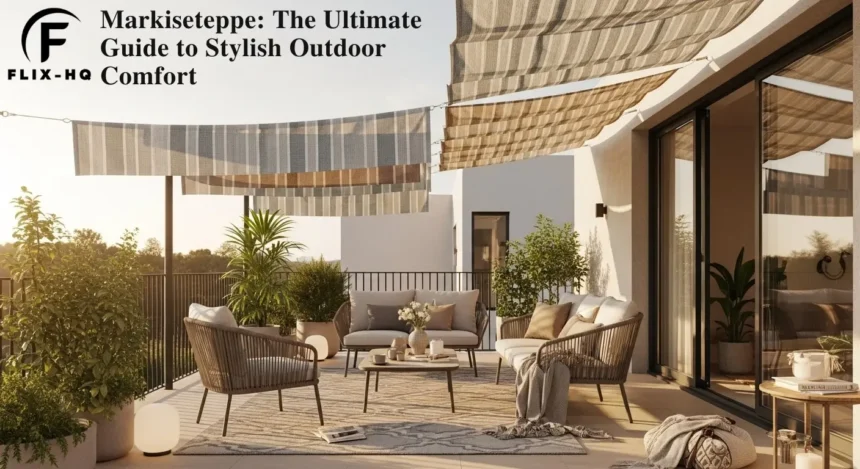Do you ever step out onto your patio or balcony and feel it’s missing something style, comfort, or a sense of cohesion, What if you could add shade, softness, elegance, and utility all in one go, Enter Markiseteppe: The Ultimate Guide to Stylish Outdoor Comfort a deep dive into a rising trend that blends awning function with textile charm.
What Is a Markiseteppe
“Markiseteppe” is a fusion of two words: markise (meaning awning or shade) and teppe (meaning carpet or textile). In essence, a markiseteppe behaves like a hybrid between an outdoor covering (awnings, shade sails) and a decorative textile (rug, fabric). Many blogs define it loosely as “awning carpets” or “textile awnings”.
However, what most gloss over is the nuance: a markiseteppe aims to do both provide functional protection from sun, rain, wind while also enhancing aesthetics and comfort underfoot. It’s not just a covering overhead, but a design element integrated into the floors, walls, or zones of your outdoor space.
How It Differs from Traditional Awnings or Outdoor Rugs
A few key differences set markiseteppe apart:
- Dual purpose: Traditional awnings shade from above; outdoor rugs soften the ground underfoot. Markiseteppe can do both or at least blend aspects of both.
- Textile integration: While awnings tend to be stiff and structural, markiseteppe is flexible, patterned, textile-like, sometimes even extending down walls or under seating areas.
- Modularity & design: Many markiseteppe systems allow retractable, modular, or patterned attachments, making them more versatile stylistically than fixed awnings.
- Stronger attention to indoor-outdoor flow: Because of its textile nature, a markiseteppe often blurs the lines between inside and outside, making transitions more seamless.
Why Markiseteppe Is Trending And Why You Should Care
Boosting Outdoor Use & Comfort
One reason markiseteppe is gaining traction is its ability to make outdoor spaces truly livable. It offers:
- Shade + UV protection: High-quality fabrics can block significant UV radiation, making patios comfortable even in full sun.
- Climate moderation: It helps reduce heat buildup, lowering surface temperatures and keeping seating areas cooler.
- Weather buffering: Light rain and wind can be softened; some markiseteppe systems help deflect sideways rain or dust.
- Soft underfoot: Unlike stone or tile, walking barefoot or in socks feels nicer, especially in warm or chill prone climates.
Aesthetic & Architectural Appeal
It’s not just function. Markiseteppe lets you:
- Use pattern, color, and texture to elevate your outdoor design.
- Define zones (lounging area, dining area, walkway) by “textile flooring” or vertical accents.
- Integrate with your home’s architectural style modern, boho, Scandinavian, tropical, you name it.
- Update the look without structural overhauls (you can change fabric panels, trim, or prints over time).
Energy & Property Value Benefits
Beyond the visual and comfort benefits:
- Some markiseteppe systems help reduce indoor cooling load by shading windows and doors.
- Because they protect furniture and flooring from sun damage, they help extend the lifespan of your investments.
- Outdoor spaces that feel usable year-round can increase a home’s market appeal.
- In fact, some sources claim markiseteppe installations can yield cost savings or home value gains (though exact figures vary).
Types of Markiseteppe
When you decide to adopt a markiseteppe, you’ll see that the choice isn’t one-size-fits-all. The top competitor blogs cover a few types (e.g. retractable, fixed, vertical) Here, I’ll expand further and include newer variants and hybrid ideas.
Retractable Markiseteppe
This is one of the more flexible types. It can be extended or retracted based on time of day, weather, or need. Ideal for:
- Patios and terraces where you want sun sometimes and shade other times.
- Seasonal climates where you want to retract during storms or snow.
- Spaces with changing orientation (morning sun vs. afternoon sun).
Many models have motorized or smart controls for ease of use.
Fixed / Permanent Markiseteppe
These are mounted installations canopies, solid roofs with textile panels, etc. Best for:
- Areas where you always want shade, such as over seating, walkways, storefront decks.
- Places where retraction is not needed due to stable climate.
- Systems that also integrate lighting or overhead trellises.
Vertical / Drop down Markiseteppe
These work like curtains or blinds but in textile form. Use them:
- To block low-angle sun (morning or evening) on facades or windows.
- To add privacy (from neighbors or passersby).
- As sidewalls to enclose outdoor spaces in breezy weather.
Modular & Hybrid Markiseteppe
This is where things get creative and many blogs don’t venture:
- Panel systems: Multiple fabric panels that can be swapped, overlapped, or layered.
- Textile ceiling + floor combos: A coordinated pair one up top, another underfoot.
- Smart/fabric hybrid: Fabric with integrated LED fibers, solar fibers, or sensor threads.
- Portable / travel markiseteppe: Lightweight mats or fabric awnings for decks, RVs, or sheds.
Adding these modular and smart varieties gives you more flexibility and future-proofing than much of the competitor content.
What to Look for When Buying Markiseteppe
Selecting a markiseteppe is more than picking a pretty pattern. Here are critical considerations going beyond many blogs cover.
Material & Fabric Quality
- UV resistance: the ability to block UV rays without fading or degrading.
- Water repellence / hydrophobic treatment prevents water soak-through.
- Breathability: avoids stuffiness or trapped heat under it.
- Strength: denser weaves, reinforced edges, anti fray stitching.
- Eco or recycled materials: many modern markiseteppe brands now use sustainable fabrics.
Size & Coverage
- Measure your area carefully (length, width, overlap allowances).
- Allow extra border for anchoring, curves, or shade coverage shifts.
- Consider shapes beyond rectangles triangles, trapezoids, custom outlines.
Pattern, Color & Aesthetic
- Light colors reflect heat but may show dirt more; darker ones hide stains but absorb heat.
- Patterns can create optical illusions (make spaces feel larger, guide pathways).
- Seasonal or reversible panels can refresh looks.
Installation & Mechanism
- Fixed vs retractable vs motorized: convenience vs cost.
- Wind sensors, motor limits, safety cutoffs.
- Mounting options: wall, roof, freestanding poles.
- Accessibility for cleaning/maintenance.
Budget & Lifespan
- Higher-end markiseteppe can last many years justify upfront cost versus frequent replacements.
- Factor in installation, wiring (if motorized), and future fabric replacement.
- Consider warranties, repair policies, and branded vs custom systems.
Performance Metrics & Maintenance Schedule:
| Metric / Factor | Ideal Target | Maintenance / Check Frequency | Adaptive Response |
|---|---|---|---|
| Fabric tension & tautness | No sagging > 1 cm | Monthly | Adjust anchors or retensioning |
| Color fade | Minimal (ΔL* < 5 units) | Biannual inspection | Rotate or replace panel |
| Seam integrity | No fraying or loosening | Quarterly | Reinforce stitching or seal edges |
| Drainage behavior | Rainwater drains within 1 min | After heavy rain | Check slope, unclog gutters |
| Grease / debris spotting | None | After outdoor cooking | Spot clean immediate |
| Motor / mechanism function (if motorized) | Smooth, quiet operation | Monthly test | Lubricate or service as needed |
FAQs
Q1: Will a markiseteppe work in regions with intense sun and heat?
Yes if you choose a high-quality UV-resistant fabric, ventilated design, and the right color (lighter tones reflect heat). Also, leave airflow gaps to prevent heat buildup.
Q2: Can I retrofit a markiseteppe onto an existing patio without structural changes?
Often yes, if walls or beams are strong enough for anchor points. Freestanding poles or surface-mount systems can sometimes avoid structural changes. You’ll just need careful planning and anchoring.
Q3: How long does a markiseteppe last?
With good materials and care, 8 to 15 years is realistic. Fabrics and mechanisms may need replacement or repair sooner depending on exposure and usage.
Q4: Is motorization worth the extra cost?
If you use the shade often, yes. Motorization adds convenience, especially for large or hard-to-reach areas. But manual retractable systems still work well for smaller spaces.
Q5: Can markiseteppe help with reducing indoor cooling demand?
Yes. By shading windows and doors from direct sun, a well-placed markiseteppe can reduce solar heat gain indoors helping lower A/C use. The effect varies based on placement and design.
Conclusion
Markiseteppe is more than a fad it’s a functional design evolution that blends style, comfort, and flexibility. When done right, it turns patios, balconies, and gardens into cozy sanctuaries that invite you to linger, dine, relax, read, or host. If you choose material wisely, consider load and wind, maintain it well, and get creative with layout and modularity you’ll end up with a durable, beautiful feature that beats many ordinary awnings or outdoor rugs.






